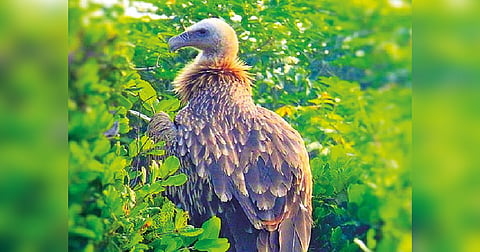

CHENNAI: In a first-of-its-kind initiative, scientists at the Wildlife Institute of India, Dehradun, have taken up a Vulture Voyage programme covering more than 8,000 kilometres. The study comprises a flock of 25 griffon vultures connecting Sathyamangalam in TN, Himalayas, Nepal, China as migrating spots of the endangered birds.
Recently, Himalayan Griffons tagged in the Panna Tiger Reserve in MP were found visiting Tibet, Nepal and China. These birds also migrate to the Moyar Valley sandwiched between The Nilgiris and Sathyamangalam. “These new movement data are crucial for the conservation of the species and the biological samples of these birds have been collected to study the impact of pesticides on TN and other parts of India,” lead scientist Dr Ramesh Krishnamurthy, WII told DT Next.
For winter migration, these birds visit central India and their scattered movements have also been recorded in south India. “So far, we have tagged 25 vultures and the movement of five vultures is constantly being monitored through GPS,” Ramesh explained. The birds visit India to avoid harsh climates. Biological samples are subjected to bioclinical and genetic studies and this data collection is an ongoing programme for five years, the WII scientist added.
“The Himalayan Griffon was sighted at Point Calimere and Coimbatore. But these are rare evidences,” said T Brinda, vulture researcher in Bharathidasan University, Tiruchy. The Himalayan vulture (Gyps himalayensis) is endemic to Central Asia Himalayas spread over China, Mongolia, Cambodia, and Nepal and also found in the Tibetan plateau. The species belongs to the group of old-world vultures and is referred to in Tamil ancient works. It is the largest species of the Gyps genus. The species is primarily found in the uplands of Central Asia and its range includes Kazakhstan, Afghanistan, western China, and Mongolia in the east, Brinda explained. A vagrant population has also been recorded in Cambodia, Thailand, Singapore, and Myanmar.
The Himalayan griffon vulture (Gyps himalayensis) is quite large and is known for its stunning size. Their population decline has generally been caused by the consumption of carcasses exposed to diclofenac, said vulture conservationist S Bharathidasan. In TN, four species (White-rumped, Long-billed, Egyptian and Red-headed vultures) were found in large numbers till the 1970s, but their numbers have dwindled drastically to a few hundreds, Bharathidasan said. The griffon vulture is a rare visitor and has been sighted in Bhavani Sagar, Moyar, Mudumalai and parts of Kerala, he added.
Visit news.dtnext.in to explore our interactive epaper!
Download the DT Next app for more exciting features!
Click here for iOS
Click here for Android